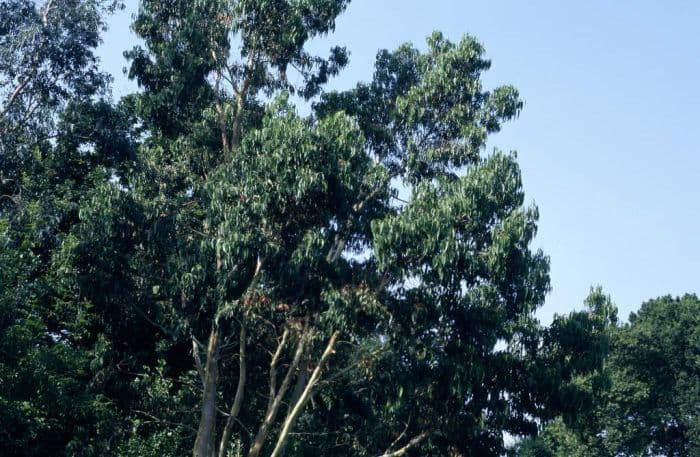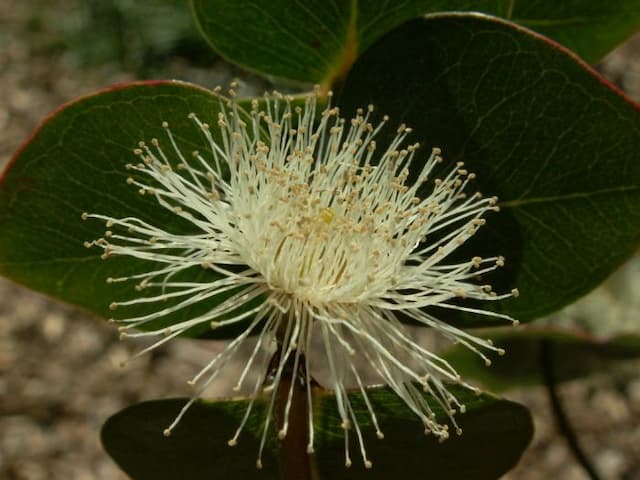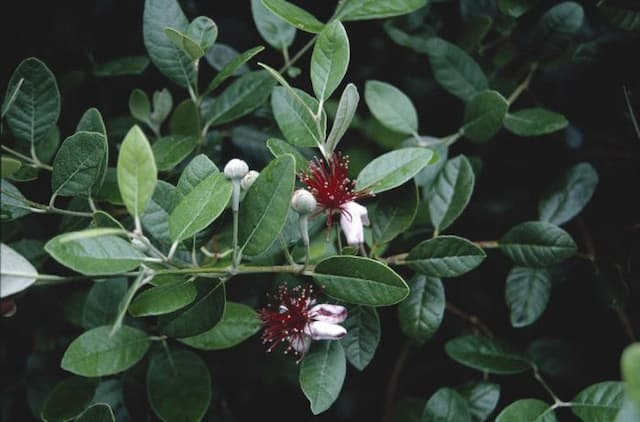Mountain gum Eucalyptus dalrympleana

ABOUT
E. dalrympleana is a fast-growing large evergreen tree with flaking white and grey bark. Juvenile leaves ovate, grey-green; mature leaves long and narrow, drooping, dark grey-green but coppery-tinted when young. Flowers white
About this plant
 Names
NamesSynonyms
Mountain Gum, Broad-leaved Kindling Bark, White Mountain Gum, Dalrymple's Gum
Common names
Eucalyptus dalrympleana
 Characteristics
CharacteristicsLife cycle
Perennials
Foliage type
Evergreen
Color of leaves
Green
Flower color
White
Height
98 feet (30 meters)
Spread
52 feet (16 meters)
Plant type
Tree
Hardiness zones
8
Native area
Australia
Benefits
 General Benefits
General Benefits- Ornamental value: Eucalyptus dalrympleana, commonly known as Mountain Gum, is often used in landscaping and gardens for its aesthetic appeal, characterized by its attractive bark and canopy.
- Habitat provision: It offers habitat and food for various wildlife species, including birds and insects.
- Soil improvement: The deep root system of Mountain Gum can help stabilize soils and improve soil structure.
- Shade and shelter: Its size and dense foliage provide shade and shelter for both humans and wildlife, which can be especially beneficial in hot climates.
- Windbreak: Mountain Gum can act as a windbreak, protecting crops, soil, and buildings from strong winds.
- Carbon sequestration: As a fast-growing tree, it has the capability to capture and store a significant amount of carbon, thereby helping to mitigate climate change.
- Timber production: Mountain Gum is valued for its strong, durable timber, which is suitable for a variety of construction and craft uses.
- Erosion control: The roots help reduce erosion by holding the soil together, particularly on sloping landscapes.
- Biodiversity support: The plant contributes to ecosystem diversity by providing various ecological niches for different species.
 Medical Properties
Medical PropertiesThis plant is not used for medical purposes.
 Air-purifying Qualities
Air-purifying QualitiesThis plant is not specifically known for air purifying qualities.
 Other Uses
Other Uses- Eucalyptus dalrympleana wood is used in the construction of didgeridoos, an indigenous Australian wind instrument, because of its natural hollows and resonance qualities.
- The bark of the Mountain Gum can be pulped and processed into high-quality specialty papers, such as artist papers, due to its strong fibers.
- Woodworkers appreciate the timber for making fine furniture and cabinetry, as it provides a durable material with an attractive grain.
- The tree's timber is also sought after for crafting musical instruments like guitar and ukelele parts, which benefit from its tonal characteristics.
- Professional florists use branches of Mountain Gum for ornamental purposes in floral arrangements because of their distinctive leaves and aesthetically pleasing look.
- The essential oils found within the leaves are sometimes used in perfumery and aromatherapy to create unique, fresh scents.
- Mountain Gum leaves can be infused in water to create a natural dye for fabrics, yarns, and fibers, offering a range of colors from tan to deep rust.
- Bees are attracted to the flowers of Eucalyptus dalrympleana, making it a valuable plant for beekeepers who use it to boost honey production.
- Eucalyptus dalrympleana wood shavings and sawdust are used in smoking meats and cheeses to impart a distinctive flavor associated with the tree's aromatic properties.
- The tree can be integrated into windbreaks and shelterbelts on farms to protect against wind and erosion, due to its fast growth and robust structure.
Interesting Facts
 Feng Shui
Feng ShuiMountain gum is not used in Feng Shui practice.
 Zodiac Sign Compitability
Zodiac Sign CompitabilityMountain gum is not used in astrology practice.
 Plant Symbolism
Plant Symbolism- Healing and Protection: Eucalyptus is widely known for its medicinal properties, particularly its ability to help clear the respiratory system, which symbolizes healing. The strong, aromatic oils it produces are thought to have protective qualities, purifying the area and warding off illness.
- Renewal: As many eucalyptus species shed their bark, this plant is often associated with renewal and fresh starts. The process of shedding and regrowing bark can be likened to overcoming past struggles and emerging renewed.
- Cleansing: The arboreal aroma of eucalyptus is also synonymous with cleansing, both physically in terms of purifying the air and spiritually in terms of clearing negative energy.
- Strength: Eucalyptus trees, including the Eucalyptus dalrympleana, are known for their hardiness and for standing tall and enduring tough conditions, making them a symbol of strength and resilience.
 Water
WaterMountain gum, the common name for Eucalyptus dalrympleana, prefers consistent moisture especially when young, but is relatively drought-tolerant once established. Young trees benefit from watering once a week with about 10 gallons during dry periods, lessening to every two to four weeks for established trees, depending on weather conditions. It's essential not to overwater, so ensure the soil is well-drained, and the top inch of soil is dry before adding more water. During winter or in cooler climates, reduce watering to match the reduced growth and evaporation rates.
 Light
LightMountain gum requires full sun to thrive, so it should be placed in a location where it can receive at least six hours of direct sunlight each day. An open, south-facing position with minimal to no shade is ideal for this eucalyptus species as it helps promote healthy growth and enhances the production of its aromatic oils.
 Temperature
TemperatureMountain gum is hardy and can withstand temperatures as low as 20°F but prefers a range of 60°F to 75°F for optimal growth. It can survive short periods of colder weather but prolonged exposure to temperatures below freezing can damage or kill the tree. Protect young saplings from extreme cold, preferably situating them in places where they can receive some warmth from buildings or natural heat retention.
 Pruning
PruningFor mountain gum, pruning is generally done to shape the young tree, remove damaged or diseased limbs, or to manage size. Prune during the tree's dormant period in the winter or early spring before new growth starts. Pruning should be done lightly and no more than once a year, as eucalyptus trees do not tolerate heavy pruning.
 Cleaning
CleaningAs needed
 Soil
SoilMountain Gum prefers well-draining soil with a liberal amount of organic matter and a slightly acidic to neutral pH between 5.5 and 7. The best soil mix can consist of 60% loam, 30% compost, and 10% perlite or coarse sand to ensure proper drainage and aeration. Regular monitoring and adjustment of the soil pH are recommended to maintain optimal conditions for growth.
 Repotting
RepottingMountain Gum should be repotted every 2 to 3 years to ensure it has enough space to grow. Younger trees may require more frequent repotting, as they grow quickly. Use the repotting as an opportunity to refresh the soil and check the root health.
 Humidity & Misting
Humidity & MistingMountain Gum thrives in moderate to low humidity conditions. It is an Australian native species that is well adapted to withstand dry air. There is no specific humidity level required, but it is important to avoid overly humid conditions to prevent issues such as fungal diseases.
 Suitable locations
Suitable locationsIndoor
Ensure full sun, use well-draining soil, and keep it cool.
Outdoor
Plant in full sun, protect from strong winds, mulch well.
Hardiness zone
7-10 USDA
 Life cycle
Life cycleEucalyptus dalrympleana, commonly known as Mountain Gum, begins its life cycle with seed germination, typically following fire or soil disturbance. The seeds require exposure to sunlight and are often dependent on fire to reduce competition and release seeds from their woody capsules. After germination, the seedling stage is characterized by rapid growth, with the plant investing energy in both root and shoot development to establish itself. During the sapling stage, Mountain Gum prioritizes height growth to reach the sunlight and outcompete other vegetation. As a mature tree, it reaches reproductive age and develops flowers; pollination is generally carried out by birds and insects. Finally, the mature Mountain Gum continuously produces seeds that are held in woody capsules until they are released by environmental triggers, such as the heat from the next fire, repeating the cycle.
 Propogation
PropogationPropogation time
Spring to Summer
The most popular method of propagating Eucalyptus dalrympleana, commonly known as Mountain Gum, is through the use of seeds. Ideal propagation time is late winter to early spring when temperatures are moderate. Seeds are first collected from ripe fruit, which release them as the fruit dries. No pretreatment of the seeds is necessary. They are directly sown onto the surface of a well-draining seed raising mix and lightly covered with a thin layer of soil. The seed raising tray is then kept moist and in a warm spot, but not in direct sunlight, to encourage germination. Germination typically occurs within two to four weeks. Seedlings are allowed to grow until they reach a sufficient size and can be transplanted outdoors after the risk of frost has passed.




